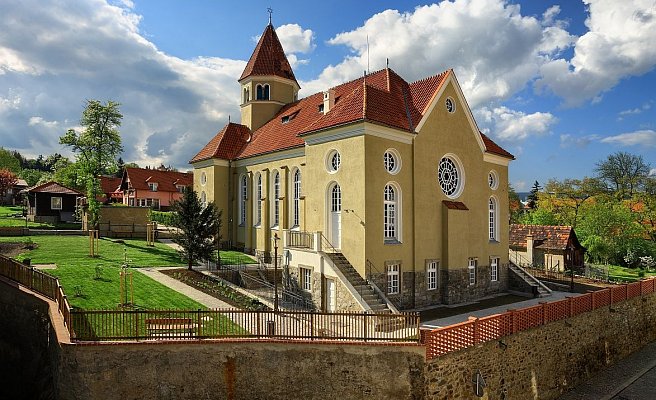
Written sources document a small number of Jews in Český Krumlov from the first half of the 14th century until the end of the 15th cen-tury, when they were forbidden to remain in town. Jews were permitted to settle in Český Krumlov again only after the middle of the 18th century. In 1855, a religious association was founded here which later changed into an independent Jewish community. In 1880, there were 103 Jews living in the city, in 1900 there were 165 (which was the highest number of Jews ever in the history of the town), and in 1930 there were 111 Jews.
The synagogue with its impressive tower was built on Švermova Street on the southern outskirts of the town in 1909-1910 based on the plans of architect Viktor Kafka and with the financial support of Ignatz Spiro. It served religious purposes until the autumn of 1938, when Nazi fanatics invaded the synagogue and destroyed the interior furnishings, including the Torah scrolls and the prayer books. Almost throughout the entire war, the building was used as a workshop that produced aircraft models for the needs of the German Luftwaffe. Af-ter the departure of the US Army, the synagogue served as a prayer hall for the Czechoslovak Hussite Church for 23 years, then from 1968 it was used as a storehouse for theater props. After 2010, the synagogue was reconstructed and has been used for cultural purposes since 2013. A small exhibition about the history of the Jews in Český Krumlov is in the winter prayer room.
The Jewish cemetery was founded in 1891 with the generous support of Ignatz Spiro in the vicinity of the town cemetery. The eclectic ceremonial hall built in the 1890’s houses a commemorative plaque commemorating his merits. There are about 115 tombstones preserved in the cemetery from the foundation of the cemetery until World War 2. The iron entrance gates decorated with the Star of David are locked.
Interesting: After the liberation of the town from May until the autumn of 1945, the synagogue was used as an interconfessional church for the soldiers of the US Army, with American field ministers alternating with spiritual leaders of the Czechoslovak Hussite Church. Today, inscriptions in English from this period are still preserved inside the synagogue.